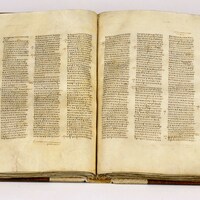Earliest Christian Bibles
Type:
Bibles,
Illuminated manuscripts
Date:
Fourth and fifth centuries
Medium:
Parchment
Description:
Christians were early adopters of the codex, the format that comes to mind for most people when they picture a book. Around the early fourth century, codices made with parchment began to overtake papyrus scrolls. Two books written in the eastern Mediterranean during the fourth century, the Codex Vaticanus and Codex Sinaiticus, are the oldest surviving copies of complete Christian Bibles. There are earlier manuscripts (including scrolls) of individual books (i.e., subsections) of the Bible, but these two codices are the oldest to bring the Old and New Testaments together into monumental, unified collections.
The slightly older Codex Vaticanus (first half of the fourth century) is named after its current repository, the Biblioteca Apostolica Vaticana (Vatican Library). The Codex Sinaiticus (mid-fourth century) is called the "Sinai Codex" because it resided for centuries at St. Catherine's Monastery on Mount Sinai. Their exact places of production are unknown and still debated.
The biblical texts are written in Greek without any spaces between words and with little punctuation or other reading aids. Although there are decorative initials visible in the Codex Vaticanus, these were added significantly later (possibly as late as the twelfth century). The newer initials sometimes replace and sometimes duplicate the first letter of the word.
The Codex Alexandrinus from the fifth century (named for the city of Alexandria, its location in the seventeenth century) has some early examples of decoration. Enlarged capitals in the margins help readers find the beginnings of new sections and decorative tailpieces appear at the ends of the biblical books. These often take the form of ornamental panels enclosing plants, baskets of fruit, or amphorae (storage vases).
The slightly older Codex Vaticanus (first half of the fourth century) is named after its current repository, the Biblioteca Apostolica Vaticana (Vatican Library). The Codex Sinaiticus (mid-fourth century) is called the "Sinai Codex" because it resided for centuries at St. Catherine's Monastery on Mount Sinai. Their exact places of production are unknown and still debated.
The biblical texts are written in Greek without any spaces between words and with little punctuation or other reading aids. Although there are decorative initials visible in the Codex Vaticanus, these were added significantly later (possibly as late as the twelfth century). The newer initials sometimes replace and sometimes duplicate the first letter of the word.
The Codex Alexandrinus from the fifth century (named for the city of Alexandria, its location in the seventeenth century) has some early examples of decoration. Enlarged capitals in the margins help readers find the beginnings of new sections and decorative tailpieces appear at the ends of the biblical books. These often take the form of ornamental panels enclosing plants, baskets of fruit, or amphorae (storage vases).
Relevant Textbook Chapter(s):
2
Repository and Online Resources:
• Flip through the Codex Vaticans on the website of the Biblioteca Apostolica Vaticana.
• Learn more about the Codex Sinaiticus on the website of the British Library.
• Flip through the Codex Alexandrinus on the website of the British Library.




